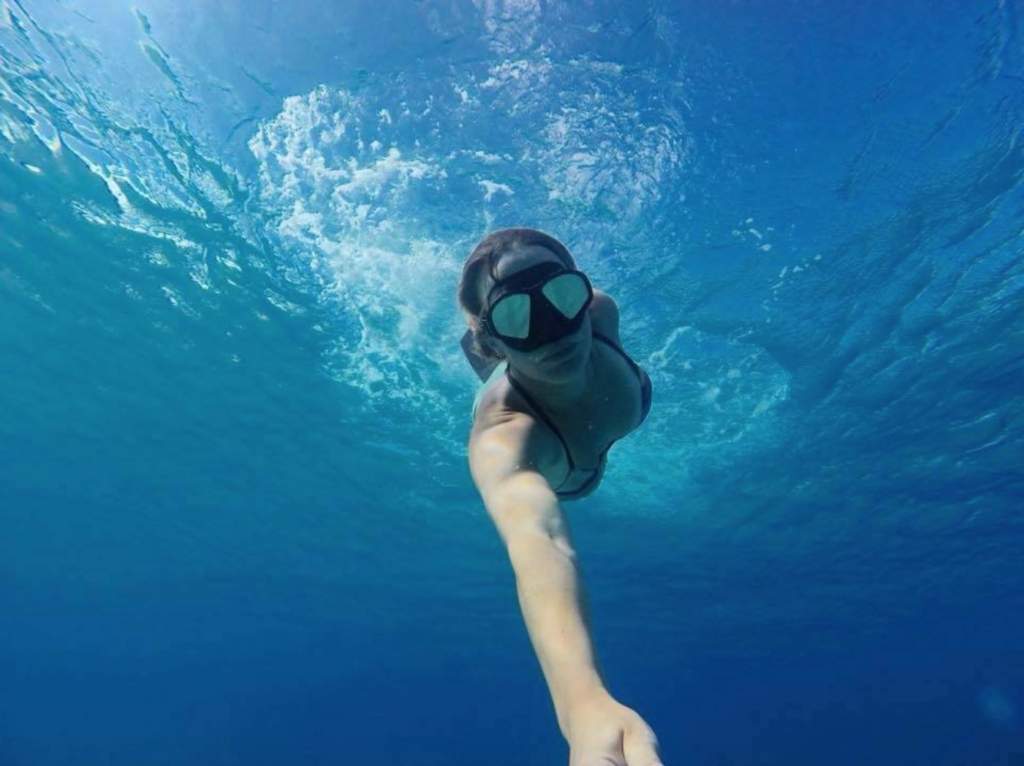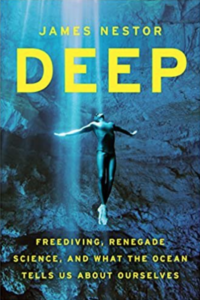

To read James Nestor’s 2014 book Deep: Freediving, Renegade Science, And What The Ocean Tells Us About Ourselves is to dive into a different world – mysterious, immersive, magical. Best known for his best-selling 2020 book Breath: The New Science of a Lost Art, Nestor’s first full-length book foray exhibits his same sense of curiosity and wonder, a remarkable adventure in which Nestor uses Deep to discern “what the ocean tells us about ourselves.”
Quick aside. Lindsey and Rob, our Peak Flow co-founders, are both lifelong lovers of the ocean. Reading Nestor’s Deep helped inspire us both to begin to pursue freediving, a unique and beautiful way to experience the underwater world, as well as a sport that presents unique challenges for breathwork practitioners.
“What brought me to freediving? Being underwater and unencumbered as a freediver reminds me of yoga – the connection to this present moment of mind, where you can really focus on yourself,” explains Lindsey, our Peak Flow CEO. (The photos above and below are of Lindsey freediving deep.) “When you are holding breath while freediving, there’s something special – your whole body and soul get into a different stage of awareness, because it’s your life that you are holding for a second and that brings you in, brings you right here. This feeling took me into freediving – not really the sport of it, or about going deep – the first drive as a freediver, for me, was healing.”
“I like what free diving champion Natalia Molchanova said about freediving,” explains Dr. Rob, our Peak Flow COO. “Freediving is not only a sport, it is a way to understand who you are.”
How can we humans learn to “throw the master switch,” rediscovering how to activate ancient aquatic evolutionary protocols that allow us to freedive deep, and access what freedivers call “the doorway to the deep”?
A few Deep-inspired breathwork observations:
Breathing underwater at depth demands we humans learn how to contend with what’s known as Boyle’s Law, the physics of how air in our bodies’ enclosed spaces is affected by changing ambient pressure (the sum of atmospheric pressure and water pressure, measured in “atmospheres” or “bar”) as freedivers descend into the depths. Boyle’s Law states that “at a fixed temperature, the volume of a gas is inversely proportional to the pressure exerted by the gas.” As pressure increases at depth, the volume of the gas decreases proportionally.
Implications for breathing at depth?
Imagine a balloon filled with air. Descend with the balloon to 10 meters (33 feet), where the total ambient pressure is two atmospheres (or 2 bar). The balloon would be one half its original size. At 20 meters (66 feet), the total ambient pressure is three atmospheres (3 bar), and the balloon is one third its original size; at 30 meters (99 feet), total ambient pressure is four atmospheres (4 bar), so the balloon is one quarter its original size, and so on. Replace the balloon with our ears, nasal cavities, sinuses, lungs, gastrointestinal tracts, and every other one of our bodies’ enclosed air spaces, and you begin to understand how breathwork is directly tied to success in freediving.
Beyond this, harnessing our breath to navigate the mammalian dive reflex, buoyancy, controlled descent into the depths, equalization via the Frenzel and Valsalva techniques, and relaxing both mind and body to optimize freediving success before, during, and after each dive – all these freediving techniques return us to the importance of breath.
The biggest challenge, from our perspective here at Peak Flow?
Mouth breathing while freediving, which runs counter to our continual emphasis at Peak Flow on nasal breathing, and the nose’s evolutionary importance as our organ most vital to optimizing human breathwork.
Stay tuned as we continue to deepen our freedive practice in the months ahead.
Back to Nestor’s book. The most remarkable elements of Deep transcend human breathwork, and indeed we humans ourselves. Nestor’s keen observational powers and unique voice bring the reader into the presence of a mysterious world of which we freediving humans are only a part. Sharks navigating via the living earth’s magnetic resonance, able to detect a freediver’s electromagnetic field with shark-like senses five million times more acute than our own. Dolphins whose echolocation skills detect objects six miles away, able to see two feet into sand as well as through human bodies. And perhaps the most remarkable moments are Nestor’s encounters with majestic sperm whales, whose powerful communicative clicks can stun and even kill other living things, including humans.
Here’s Nestor taking us under water, recreating his close encounter with these denizens of Deep:
The whales’ clicks “sound like jackhammers on a pavement,” as they close in, scanning Nestor inside and out as he strives to think good thoughts.
“The calf floats just in front of its mother and stares with an unblinking eye. Its mouth is turned up, like it’s smiling. The mother wears the same expression; all sperm whales do,” Nestor writes. “I felt a sudden recognition, an instant and ineffable sense of knowing that I was in the presence of something extraordinarily powerful and intelligent. This is not a scientific observation of course, but an emotional one.”
Nestor discovers that the sperm whales, the dolphins, the sharks, and the many other deep-sea creatures he encounters remind us that “this is the real earth, the 71 percent silent majority.” “And this is how it looks,” he explains, “gelatinous, cross-eyed, clumsy, glowing, flickering, cloaked in perpetual darkness and compressed by more than a thousand pounds per square inch.”
Deep is a remarkable book, a beautiful celebration of our living ocean’s deep and abiding mysteries, and an eye-opening reminder of how little we truly know about the inhabitants of our aqueous planet. “The azure sphere we see from space is only a veneer,” Nestor concludes after returning from the depths in a homemade submarine. “Our planet isn’t really blue, it’s not filled with leaves of grass, clouds, color and light. It’s black.”
And the blackness of our ocean’s depths is indeed beautiful.
Dive Deep with James Nestor, and be amazed by “what the ocean tells us about ourselves.”





